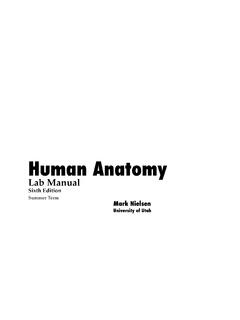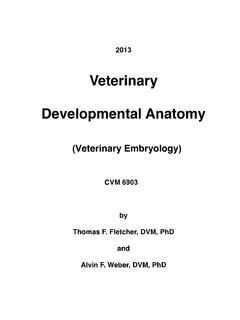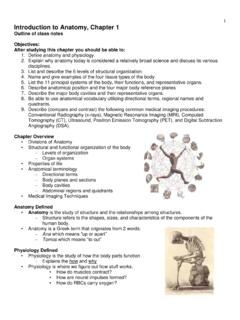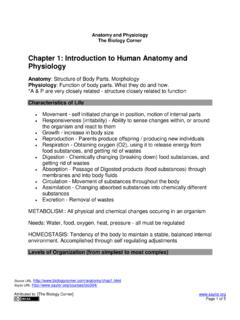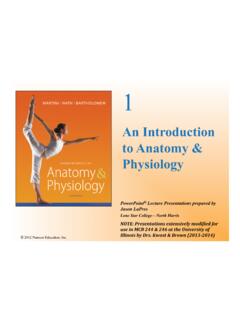Transcription of Rabbit Anatomy Rabbit Body Systems - SLHS AP Biology
1 1 Rabbit Anatomy - Rabbit Body Systems Rabbit Anatomy - Body Areas Rabbit Anatomy - Systems Skeletal Muscular Digestive Urogenital SystemA) urinary SystemB) Reproductive Dental Sense SystemA) EyesB) NoseC) EarsCLASS SET2 Rabbit Anatomy - Skeletal system The Rabbit has a delicate skeleton compared with other mammals. It makes only 8% of the body weight, as compared to 12 to 13% in cats. Here are some other important points to note about the Rabbit skeletal system : There are 46 bones that make up the spinal column alone, 7 cervical (the neck), 12 thoracic (the chest), 7 lumbar (the lower back), 4 sacral (the pelvis) and 16 coccigeal (the tail).
2 A Rabbit 's bones have extremely thin cortices and are easily shattered. The lumbar vertebrae are elongated to allow for considerable flexion and extension during hopping, but this makes them susceptible to fracture. The powerful hind limb musculature and light skeleton enable powerful jumping over long distances. The hopping movement is made possible due to the hind legs being longer than the fore legs. Most of the elongation is below the stifle (the knee) in two bones, the tibia and fibula. The tibia is also prone to fracture. Rabbit 's hind legs can kick out with extreme force and if they struggle when they are picked up, or even when they stamp their feet violently on the ground, they are prone to fracture of their backbones (usually the 7th lumbar vertebra) and damage their spinal cord.
3 Rabbits have 7 tarsal bones (the ankle) and 4 digits on both hind legs, and 9 carpal bones (the wrist) and 5 digits on both fore legs. Each digit has an associated toenail. Weakened bones and bones affected by osteoporosis are easily injured or broken. Various types of spinal deformations have been observed in a Rabbit 's Anatomy . The degree of curvature is variable and may range from mild and barely visible to severe and causing gait problems. The origin of these congenital deformations is not well understood, they include: hemivertebrae - abnormal birth defect in which the vertebra fails to develop completely. As a result of the growth defect of the spine, a wedge-shaped vertebra develops, and neighboring vertebrae expand or tilt to fit the deformity spondylosis - a condition of the spine marked by stiffness of a vertebral joint kyphosis - humplike curvature of the spine lordosis - abnormal, increased degree of forward curvature of any part of the spine) These conditions may relate to a number of factors, a lack of calcium in the food, improper absorption of calcium in the intestine, lack of exercise, wrong posture due to being kept in a small cage, or defective genes.
4 Female rabbits appear more frequently affected by these spinal abnormalities than males. It is linked to their higher needs in calcium, especially during pregnancy and lactation. Rabbits suffering from weak muscles and poorly mineralized bones and/or bone degeneration are at increased risk of spine fracture when there is an inadequate support of the heavily muscled hindquarters, walking on a slippery floor, or twisting of the lumbosacral junction when frightened or restrained. 3 Rabbit Anatomy - Muscular system Wild rabbits are very athletic animals that are built to move rapidly in order to find food, water, find or fight mates, or flee predators over greater distances to find a hiding place.
5 This daily exercise strengthens the locomotive muscles, fortifies the muscles in their heart and lungs and increases their resistance against stress. Just like us, exercise is wonderful for fortifying muscle and bones, it will stimulate blood circulation and the activity and functioning of other organs including the digestive system . The vertebrae of the spine provide support for the back. If this is accompanied by poorly developed transversospinalis spine muscles and trunk muscles, the normal balance of the spinal structure and the biomechanics can be altered, which can lead to degenerative processes. Deformations appear that will prevent the development of a good locomotric activity.
6 Intrinsic muscle imbalance leads to degenerative changes of the lumbar vertebrae, even changes to femoral head have been observed in rabbits that lack exercise. The Rabbit muscular system , like in any vertebrate, is controlled by the nervous system , it's the basic concept of any muscular system . Muscles are controlled through electrical signals between the body's parts and the brain. 4 Rabbit Anatomy - Digestive system As total herbivores, rabbits have an extremely long digestive tract in order to process their food in the most efficient way. The whole of a Rabbit Anatomy has evolved to survive on a very poor diet, the digestive tract especially.
7 A special feature of the process, known as caecotrophy, is a remarkable way the Rabbit 'recycles' waste fecal matter in order to extract any nutrients that may have been missed on the first, second or even third time round in the digestion system . The whole digestive system of the Rabbit is huge and may account for between 10-20 per cent of its total body weight. Let's follow the process through the Rabbit 's Stomach In an adult Rabbit the total length of the alimentary canal is to 5 m. After a short esophagus there is a simple stomach which stores about 60-80 g of a rather pasty mixture of feedstuffs. Food eaten by the Rabbit quickly reaches the stomach where it remains for a few hours, and although in an acid environment it has little chemical change.
8 5 Liver & Pancreas Two major glands secrete into the small intestine: the liver and the pancreas. Bile from the liver contains bile salts and many organic substances but no enzymes. Bile aids digestion catalytically. The reverse is true of pancreatic juice which contains a sizable quantity of digestive enzymes allowing the breakdown of proteins (trypsin, chymotrypsin), starch (amylase) and fats (lipase). Small Intestine If the small intestine of a Rabbit were laid out it would be more than 10 times the length of the Rabbit . The contents of the stomach are gradually 'injected' into the small intestine in short bursts, by strong stomach contractions.
9 The small intestine is about 3 m long and nearly 1 cm in diameter. The contents are liquid, especially in the upper part. Normally there are small tracts, about 12 cm long, which are empty. The small intestine ends at the base of the cecum. This second storage area is about 40-45 cm long with an average diameter of 3-4 cm. It contains 100-120 g of a uniform pasty mix with a dry matter content of about 20 percent. As the contents enter the small intestine they are diluted by the flow of bile, the first intestinal secretions and finally the pancreatic juice. After enzymatic action from these last two secretions the elements that can easily be broken down are freed and pass through the intestinal wall to be carried by the blood to the cells.
10 Large Intestine The large intestine is made up of the cecum and colon. The cecum is very large, (about 10 times the volume of the stomach, and about 40 per cent of the total volume of the gastrointestinal tract). The colon separates the large and small fiber particles. The large particles of indigestible fiber are moved straight through the colon to form the hard droppings. The smaller fiber particles and other small incomplete digested food particles are moved backwards (by special muscles in the colon called haustrae). This 'slurry' enters the cecum where it is broken down and fermented. Cecum The particles that are not broken down in the small intestine enter the cecum after less than 2 hours.
